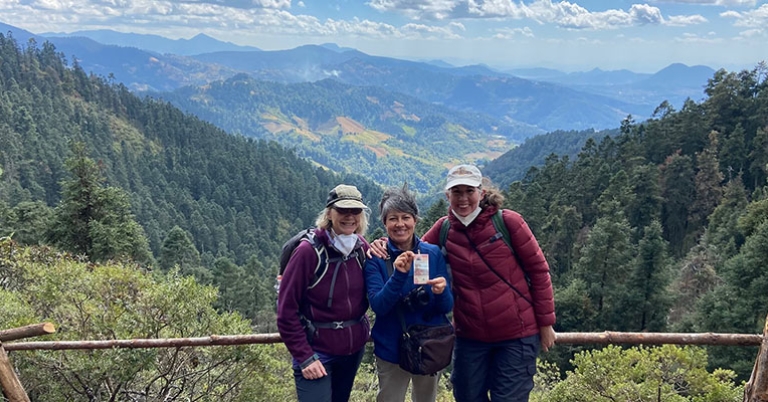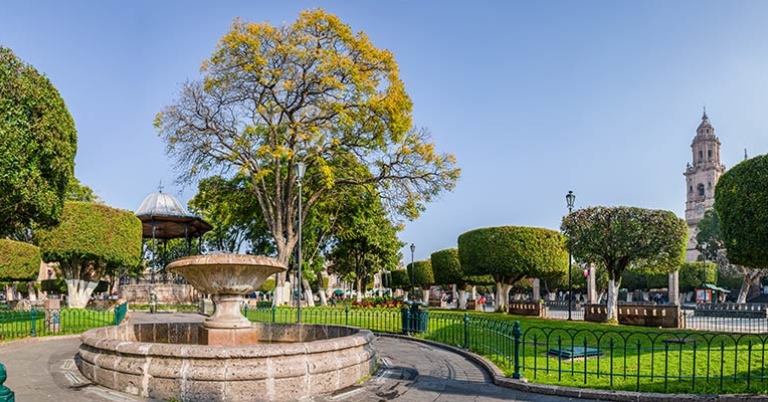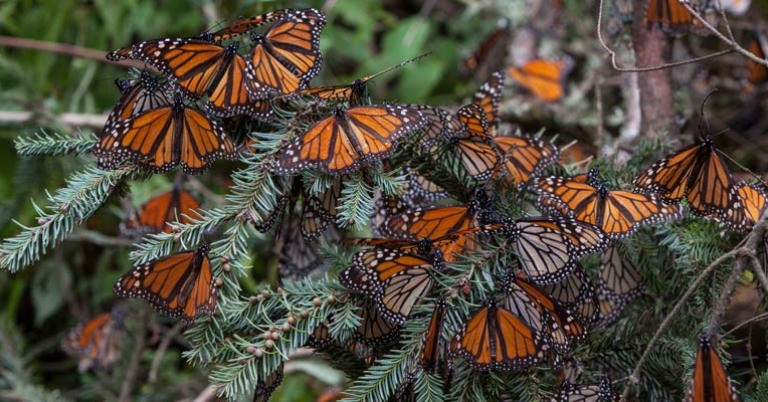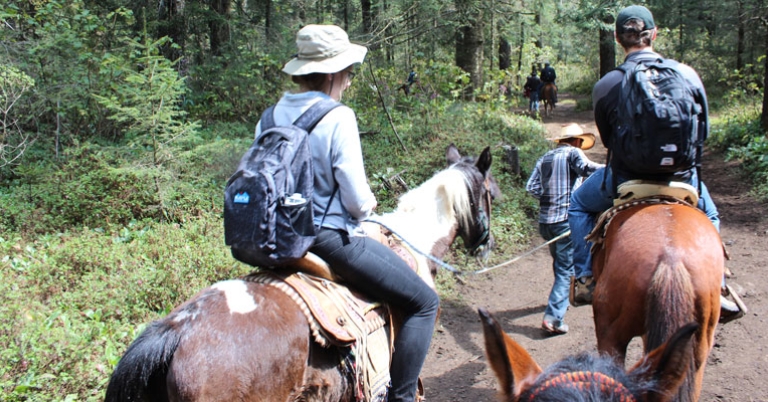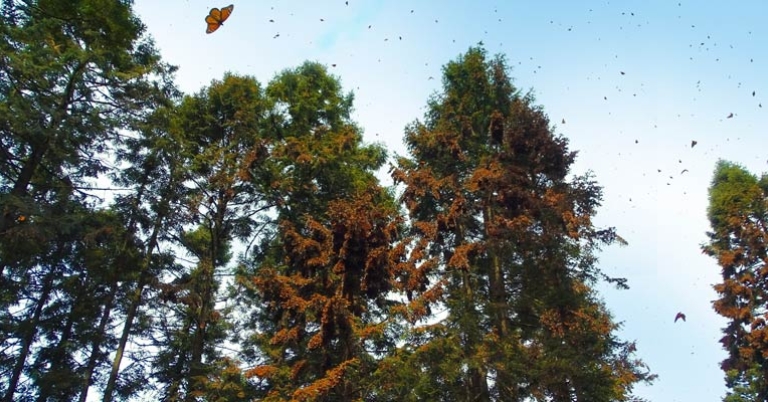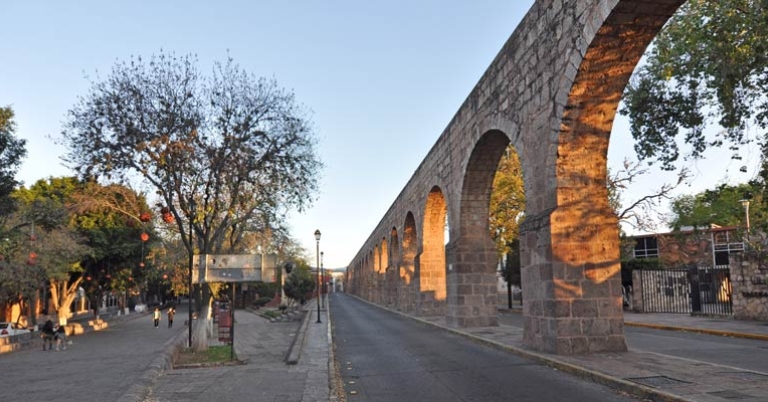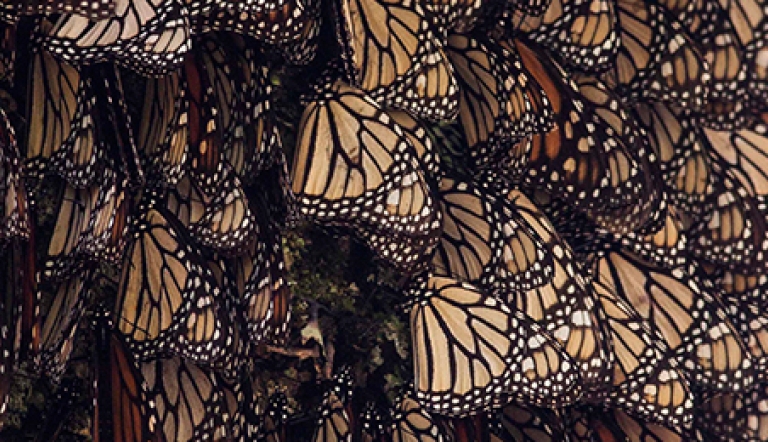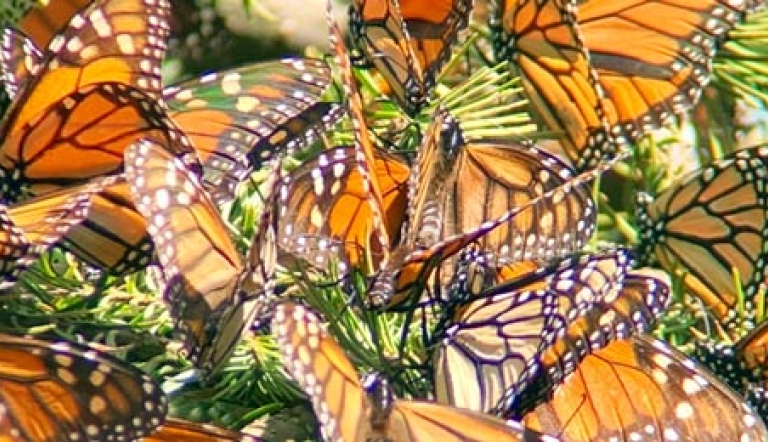Mexico | Migration of the Monarch Butterflies
About this trip
One of the most amazing phenomena in nature is the epic annual migration of eastern Monarch butterflies (Danaus plexippus) southward from their breeding grounds in the United States and Canada to overwintering sites high in the mountains of central Mexico. Hundreds of millions of Monarchs fly up to 3000 miles to eventually reach the belt of high volcanic mountains which stretches across the southern end of the central Mexican plateau. At about a dozen isolated places within the high-altitude forests of this zone, Monarchs pass the winter in aggregations that can exceed 2 billion individual butterflies. Stand amid the fir-covered mountains and witness this awe-inspiring spectacle firsthand as the monarchs flutter, dip, and swoop overhead.
Highlights
- Spend time exploring the city of Morelia and take in its rich culture and history.
- Hike or ride horseback to three different monarch reserves, where millions of individual monarch butterflies gather.
- Photograph the dramatic colors of the butterflies as they hang in clusters from the trees, drink from streams, feed on wildflowers, and soar in the air above.
- Spend time exploring colonial Angangueo, which was once a mining town but now derives most of its livelihood from butterfly ecotourism and agriculture.
Meet Your Leaders
 Susan Meyers
Susan Meyers
After visiting the Mexican overwintering colonies with Dr. Bill Calvert in March 2003, Susan began volunteering with Monarchs Across Georgia (MAG), a committee of the Environmental Education Alliance of Georgia. She facilitates educator workshops using the Monarchs & More curriculum and incorporates community science projects such as Monarch Larva Monitoring Project, Journey North tracking, Monarch Watch tagging, and Project Monarch Health. She administered MAG's Pollinator Habitat Restoration Grants (2012-2020) through the US Fish and Wildlife Service and was honored with a Conservation Partner Award for her work with monarchs.
Organizing trips to the Mexican overwintering colonies since 2004, she initiated the Mexico Book Project, bringing books written in Spanish to schools near the sanctuaries. In 2018, Susan was selected to coordinate the Symbolic Monarch Migration, a 22-year-old program created by Journey North. This annual tri-national project mimics the monarchs’ journey by engaging thousands of youth from across the United States and Canada in creating paper butterflies to send to the students in Mexico. As real-life monarchs arrive in Mexico for the winter, these symbolic monarchs are delivered to schools surrounding the Monarch Butterfly Biosphere Reserve. In the spring, as living monarchs return north so will the paper butterflies carrying messages from the students in Mexico.
Susan received her BS in Microbiology and MS in Environmental Science from Louisiana State University, Baton Rouge, and Florida Institute of Technology, Melbourne respectively. She retired in 2012 as an instructor from Stone Mountain Memorial Association where she taught K-12 students a variety of science-based lessons from geology to life cycles. Susan is also a Georgia Master Gardener, Master Naturalist, and certified Environmental Educator.
Kim Bailey
Working in the field of education for over 25 years, Kim has enjoyed a wide range of experiences including teaching middle school life science classes, leading wilderness adventure trips, directing outdoor environmental education programs, and training teachers and naturalists. She has also volunteered for Master Gardeners, Master Pomologists, Georgia Native Plant Society, Monarch Across Georgia, Bee City USA, and National Wildlife Federation’s Habitat Stewards. She first visited the monarch overwintering sanctuaries in Mexico in 2002 and has since co-led many trips to the monarch biosphere region. Over the years, she became enamored with natural history of Michoacán as well as its many cultural and culinary delights.
In 2014, Kim moved to family property located in the mountains of Western North Carolina and founded Milkweed Meadows Farm. Generations ago, the land was a working dairy farm. Today, instead of producing milk, the farm grows milkweed, specialty fruits such as pawpaw and native passion fruit, pollinator-friendly potted plants, heirloom vegetable seeds, wildflower seeds, and cut flowers. Kim not only enjoys gardening for bees, butterflies, hummingbirds, and other wildlife at the farm, but loves sharing knowledge about creating pollinator habitats with others. She has a true passion for pollinators and is a frequent speaker at local and regional symposia, events, and schools. Educational programs and/or farm tours for groups are also regularly scheduled onsite at Milkweed Meadows.
Kim holds a BS in Biology and Secondary Education and a MS in Curriculum and Instruction. When not out digging in the dirt or selling plants at local farmers markets and garden festivals, she enjoys hiking local trails with her two Carolina dogs, trying out new recipes as part of an adventuresome cooking club, and attempting to fly fish.
$3,200
Per person
About this price
Land cost only. Does not include round-trip airfare to and from destination.
Single room supplement $550
What makes us different
Rich content
Wildlife up-close
Value for your money
Expert guides
Flight arrangements
Service anytime
Daily Itinerary
Print ItineraryMorelia
Morelia
Angangueo
Cerro Pelon
Cerro Pelon
Morelia
Pricing
Print Pricing$3,200
Per person
About this price
Land cost only. Does not include round-trip airfare to and from destination.
Single room supplement $550
What's Included
- Activities and meals as mentioned in itinerary
- Full time guide for the duration of your program
- Private transportation and driver for the duration of the program
- All Tips except Guide and Driver
- Arrival and departure transfers based on individual flight schedules
- Carbon Offset
- Non alcoholic beverage with meals
- Horseback ride during visit to Cerro Pelon Reserve
What's Not Included
- International airfare
- Items of personal nature
- Tips for guide and driver
- Travel Insurance
- Horseback ride during visits to Sierra Chincua and El Rosario
Pricing Details
Full land payment of $3200 is due to hold space on this trip. This payment is not refundable; 100% cancellation fee.
Holbrook Travel strongly recommends the purchase of travel protection for medical emergencies while traveling and to protect your investment. Please note the purchase of Cancel for Any Reason Coverage or to exclude pre-existing conditions with Trip Cancellation coverage may require policy purchase within 10-14 days of your initial deposit, depending upon the provider.
Single room supplement $550
Final payment due date: August 30, 2024
Travel Info
Print Travel InfoActivity Level 4: Moderate-Strenuous
This journey is for fit and active nature enthusiasts. Daily activities last for 5 or more hours. There are challenging excursions to butterfly colonies that may require walking for approximately 2 miles at altitudes of up to 10,660 feet on some trails that are narrow and rugged. These may involve both steep uphill and downhill hikes of 30 minutes or more (hiking at your own pace), and require horseback riding for part of the way; please note there is a maximum weight limit of approximately 260 lbs to ride the horses. Restrooms are only available at the base of the mountain. Weather in the Central Highlands during the migration is typically cool and dry with average temperatures in the 50s. Though days are typically sunny, there can be some windy conditions, and nights occasionally drop below 30°F. Also included are walking tours in provincial towns.
Safety & Risk Management
Please note that this program visits the Mexican state of Michoacán, which the U.S. State Department has long designated a Travel Advisory Level 4 due to criminal activity. Holbrook has operated programs to view the monarch migration in these locations for many years without incident, and we have strict safety protocols in place for all our destinations. However, it is ultimately up to each traveler to make their own assessment regarding safety and risk. Travelers are advised to visit https://travel.state.gov for more information.
Entry & Exit Requirements
U.S. citizens must have a valid passport to enter Mexico. Passports must be valid for at least the duration of your stay. As this requirement is subject to change at any time without notice, we recommend at least 6 months’ validity. A passport card is not acceptable for entry to the U.S. by air.
If you are not traveling with a U.S. passport, please check with the Mexican Embassy for the requirements based on your nationality.
Health Information
COVID-19 TESTING
If symptoms are present or you have recently been exposed to another person with a confirmed case of COVID-19, you will be subject to a test. If the test is positive, isolation will be required at your own expense. If your travel is delayed due to a positive test result, Holbrook and our in-country partners will assist you to make the necessary arrangements for isolation. You may not rejoin your group until you have two sequential negative antigen tests 48 hours apart.
IMMUNIZATIONS
The Centers for Disease Control recommends that all travelers be up to date on routine vaccinations such as measles-mumps-rubella (MMR) vaccine, diphtheria-pertussis-tetanus vaccine, varicella (chicken pox) vaccine, and your yearly flu shot before every trip.
There are no vaccinations required for entry into Mexico. Though not required, the CDC recommends inoculation against hepatitis A, hepatitis B, and typhoid for most unvaccinated travelers to Mexico.
Please consult your physician for additional information and recommendations based on your individual circumstances.
MALARIA
The CDC does not consider travelers to the Mexican state of Michoacán to be at risk for malaria.
Dengue Fever & Other Insect-borne Illnesses
Locally transmitted cases of dengue fever have been reported in Mexico. Local transmission means that mosquitoes in the area have been infected with the virus and are spreading it to people. In addition, locally transmitted cases of leishmaniasis, Zika virus, and other insect-borne illnesses have been reported in Mexico.
There are no vaccinations available to protect against dengue, leishmaniasis, or Zika. The CDC recommends that travelers to Mexico protect themselves against insect bites. Cover exposed skin with lightweight, long-sleeved shirts and pants and use an insect repellent containing an active ingredient like DEET or picaridin. Apply sunscreen first, followed by the repellent (preferably 20 minutes later). As a precaution, the CDC advises women who are pregnant to consider postponing travel to any area where Zika virus transmission is ongoing.
Altitude Sickness
The high elevations of Michoacán might cause some travelers to experience altitude sickness during this program. Please discuss appropriate preventative measures with your personal physician prior to travel.
The most common form of the illness is acute mountain sickness (AMS). Symptoms generally include: headache, fatigue, loss of appetite, nausea, and at times, vomiting. The two more serious, and less common, forms of altitude illness are high-cerebral edema (HACE) and high-altitude pulmonary edema (HAPE). HACE and HAPE can be potentially fatal if left untreated. Symptoms include: profound lethargy, extreme confusion, and increased breathlessness.
To alleviate symptoms of altitude sickness: stay hydrated and well-rested; eat high-carbohydrate foods; and avoid heavy, fatty foods, alcohol, sleeping pills, or narcotics during travel and in the days before arrival. Avoid heavy exercise while staying at high elevations.
Visit the CDC website for more information.
Travelers’ Diarrhea
The CDC warns that travelers’ diarrhea is the most common travel-related illness. Consumption of contaminated food and water may cause diarrhea. To avoid this, do not drink tap water, and use bottled water to brush your teeth. Avoid ice and uncooked vegetables or fruit without a peel. When in doubt, ask your guide. Restrict yourself to cooked food at restaurants, and avoid food sold on the streets. If you contract diarrhea, it is very important to drink large quantities of purified water. Consult your doctor for appropriate medication should you contract diarrhea.
SUN EXPOSURE
The effects of the sun can be damaging to the eyes and skin. Spending time outdoors exposes you to the sun’s harmful ultraviolet (UV) rays, even on cloudy days. To protect yourself from the sun, use a broad spectrum sunscreen of at least SPF 15, protect skin with clothing, wear a wide-brimmed hat and sunglasses, and drink plenty of fluids.
Respiratory Illness Protocols
Please review our Respiratory Illness Protocols page, which explains our policy and procedures if you or another traveler should develop symptoms of a respiratory illness during your trip. Your participation in a Holbrook Travel program indicates that you are in agreement with these protocols.
Resources
Print ResourcesSuggested Packing List
Everyone has personal preferences when it comes to packing; for this reason, the information below is offered as a general guide and not a definitive list. You know yourself best: Use your discretion and pack what you think will serve you, based on your personal preferences and specific itinerary.
You may find many of these items in our Gear Store.
CLOTHING
Casual, comfortable field clothes are suitable for visits to the monarch sites and most other activities. You may wish to bring one or two slightly nicer, but still casual, outfits for your time in Morelia.
Bring enough clothing suitable for the length of your program. Make sure to bring warm clothes, as the temperatures at 10,000 feet can be at or below 30 °F in the early morning. It can also be windy on the mountains. Layering is strongly encouraged, as the mid-day temperatures may be in the 60s or 70s. The climate in Morelia is warm and temperate. Versatility is key.
- A combination of short-sleeved and long-sleeved shirts suitable for layering
- A combination of light- and medium-weight long pants (such as jeans, khakis, or field pants)
- Undergarments; long underwear and warm socks may be useful at night, as the rooms at Hotel Don Bruno are unheated and could get rather cold
- Warm sleepwear
- Parka or other outerwear: Temperatures may be near freezing for the first hour or two of the day.
- Socks – Bring extra pairs.
- Shoes – You'll likely want at least one pair of hiking boots for dusty forest trails or riding horseback (if desired), and/or a pair of comfortable, well-worn, closed-toe shoes with rubber soles suitable for walking on cobblestone streets, gravel paths, and uneven surfaces. In addition, you may want a pair of sturdy sport-strap sandals (e.g. Keens, Tevas, or similar) and/or casual flip-flops or sandals.
- Rain gear – Rain is infrequent this time of year, but a lightweight rain jacket or hooded poncho comes in handy should a slight drizzle or snow flurry occur. It also makes a great layer for added warmth.
- Cap or wool hat
- Bandana, scarf, or neck gaiter – These can be helpful on dusty trails.
- Gloves
- Hand warmers – Hand warmers are small, heated pouches found in outdoor sections of many large retail stores as well as specialty sports and camping stores. When you open their packaging, the oxygen reacts with the powder inside the pouches to create heat, and after about 30 minutes they heat up to 120 °F, last for about 6-10 hours, and provide considerable warmth. They come in a variety of sizes and are inexpensive. These have been very popular with travelers in the past and are another way to ensure that you are comfortable during the cool mornings and nights. Due to current security regulations at airports, we recommend you pack these in your checked luggage, NOT your carry-on bag.
Personal Toiletries
Pack toiletries based on your personal preferences and habits. Below are just a few recommendations to keep in mind.
- Shampoo, conditioner, lotion, deodorant/antiperspirant , etc. – All hotels provide shampoo and soap, but you may wish to bring your own from home if you prefer. If possible, avoid strong fragrances in consideration of your fellow travelers.
- Soap and washcloth or a small, quick-drying microfiber towel – These items are not always standard in hotels outside the US, so you may wish to bring them with you.
- Hairbrush, comb, hair ties, shower cap
- Toothbrush and toothpaste
- Razor
- Ear plugs, especially if you are a light sleeper
- Personal hygiene products
- Insect repellent with an active ingredient like DEET or picaridin
- Sunscreen and lip balm with SPF – There is a chance for sunburn when on the mountain
- A travel pack of tissues – also useful as napkins or toilet paper if needed, as it may not be available at all stops
In addition to your personal toiletries, it is useful to pack a small medical kit, which you can easily prepare. Helpful items might include: bandages, antihistamine, a pain reliever (may be helpful for altitude headaches), motion sickness and/or altitude sickness medication (if you are prone to either), anti-diarrhea medicine, individually wrapped pre-moistened towelettes and/or hand sanitizer, antibiotic ointment, anti-fungal cream, moleskin for blisters, eye drops, tweezers, a mini sewing kit, and an extra pair of disposable contact lenses or eyeglasses if you wear them.
MISCELLANEOUS
Remember to pack valuables such as your passport, cash/credit cards, and medications in your carry-on luggage.
- Passport and photocopies of all travel documentation
- Personal insurance card and travel insurance information
- Money – ATM/credit card and cash; small bills in good condition are recommended
- Prescription medicines (if applicable), with a copy of the prescription
- Sunglasses with strap
- Small day pack for carrying water, camera gear, rain gear, clothing layers, etc. during monarch site visits
- Flashlight and/or head lamp
- Travel alarm clock or inexpensive wristwatch with alarm – Not all hotels provide alarm clocks.
- A pocket calculator or phone to assist with conversions and currency exchange
- Hot water bottle (to help warm your bed at Hotel Don Bruno
- Binoculars with lens cleaner
- Camera and related equipment, such as charger, lenses, and extra memory cards – Be prepared to pay an extra park fee for use of a video camera (anything that looks professional-level) while in the parks.
- Reusable water bottle – Plan to buy bottled water, but you may wish to bring an extra container for refilling
- Non-perishable snacks
- Pocket-knife or multipurpose tool – Pack in your checked luggage
- Notepad or travel journal and pen
- Music or reading material for down time, long bus drives, or on the airplane, and a portable bright light to read by
- Collapsible walking stick with rubber tip
- Zip-top style bags – useful for packing toiletries, sorting clothing, storing damp or muddy shoes, or as a dry bag for protecting electronics
- Money belt
- Chargers for electronics

Questions
Contact Lisa Palmese-Graubard at 800-451-7111 x339 or lisa@holbrooktravel.com.
